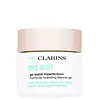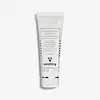What's inside
What's inside
 Key Ingredients
Key Ingredients

 Benefits
Benefits

 Concerns
Concerns

 Ingredients Side-by-side
Ingredients Side-by-side

Water
Skin ConditioningC9-12 Alkane
SolventButylene Glycol
HumectantGlycerin
HumectantPropylene Glycol
HumectantSilica
AbrasiveCocos Nucifera Fruit Juice
EmollientSodium Carbomer
Emulsion StabilisingSilica Silylate
EmollientAmmonium Acryloyldimethyltaurate/Vp Copolymer
Hydroxyacetophenone
AntioxidantParfum
MaskingTartaric Acid
BufferingHibiscus Sabdariffa Flower Extract
Skin ConditioningDisodium EDTA
Caprylic/Capric Triglyceride
MaskingTamarindus Indica Extract
SmoothingSodium Hydroxide
BufferingSpiraea Ulmaria Extract
AstringentMarrubium Vulgare Extract
Skin ConditioningLycium Barbarum Fruit Extract
AstringentCitric Acid
BufferingFicus Carica Fruit Extract
HumectantGentiana Lutea Extract
EmollientMalpighia Emarginata Seed Extract
Skin ConditioningPhenethyl Alcohol
MaskingFurcellaria Lumbricalis Extract
Skin ConditioningSodium Benzoate
MaskingRhododendron Ferrugineum Extract
MaskingArbutus Unedo Fruit Extract
AntioxidantPotassium Sorbate
PreservativeSorbic Acid
PreservativeLapsana Communis Flower/Leaf/Stem Extract
Skin ConditioningMaris Sal
Skin ConditioningCI 15985
Cosmetic ColorantCI 14700
Cosmetic ColorantWater, C9-12 Alkane, Butylene Glycol, Glycerin, Propylene Glycol, Silica, Cocos Nucifera Fruit Juice, Sodium Carbomer, Silica Silylate, Ammonium Acryloyldimethyltaurate/Vp Copolymer, Hydroxyacetophenone, Parfum, Tartaric Acid, Hibiscus Sabdariffa Flower Extract, Disodium EDTA, Caprylic/Capric Triglyceride, Tamarindus Indica Extract, Sodium Hydroxide, Spiraea Ulmaria Extract, Marrubium Vulgare Extract, Lycium Barbarum Fruit Extract, Citric Acid, Ficus Carica Fruit Extract, Gentiana Lutea Extract, Malpighia Emarginata Seed Extract, Phenethyl Alcohol, Furcellaria Lumbricalis Extract, Sodium Benzoate, Rhododendron Ferrugineum Extract, Arbutus Unedo Fruit Extract, Potassium Sorbate, Sorbic Acid, Lapsana Communis Flower/Leaf/Stem Extract, Maris Sal, CI 15985, CI 14700
Water
Skin ConditioningGlycerin
HumectantButylene Glycol
HumectantCoco-Caprylate/Caprate
EmollientIsodecyl Neopentanoate
EmollientArachidyl Alcohol
EmollientBambusa Arundinacea Stem Extract
Skin ConditioningBehenyl Alcohol
EmollientCaprylyl Methicone
Skin ConditioningDimethicone
EmollientPanthenol
Skin ConditioningTocopheryl Acetate
AntioxidantBoswellia Carterii Resin Extract
MaskingStyrax Benzoin Resin Extract
MaskingAlthaea Officinalis Root Extract
Skin ConditioningArctium Majus Root Extract
Skin ConditioningCommiphora Abyssinica Resin Extract
Skin ConditioningAlchemilla Vulgaris Extract
AstringentOrthosiphon Stamineus Extract
Skin ConditioningPotassium Cetyl Phosphate
EmulsifyingArachidyl Glucoside
EmulsifyingSodium Polyacrylate
AbsorbentHydroxypropyl Starch Phosphate
Disodium EDTA
Citric Acid
BufferingXanthan Gum
EmulsifyingMaltodextrin
AbsorbentEthylhexylglycerin
Skin ConditioningParfum
MaskingPhenoxyethanol
PreservativeSorbic Acid
PreservativeGeraniol
PerfumingAmyl Cinnamal
PerfumingAlpha-Isomethyl Ionone
PerfumingLinalool
PerfumingBenzyl Benzoate
AntimicrobialLimonene
PerfumingWater, Glycerin, Butylene Glycol, Coco-Caprylate/Caprate, Isodecyl Neopentanoate, Arachidyl Alcohol, Bambusa Arundinacea Stem Extract, Behenyl Alcohol, Caprylyl Methicone, Dimethicone, Panthenol, Tocopheryl Acetate, Boswellia Carterii Resin Extract, Styrax Benzoin Resin Extract, Althaea Officinalis Root Extract, Arctium Majus Root Extract, Commiphora Abyssinica Resin Extract, Alchemilla Vulgaris Extract, Orthosiphon Stamineus Extract, Potassium Cetyl Phosphate, Arachidyl Glucoside, Sodium Polyacrylate, Hydroxypropyl Starch Phosphate, Disodium EDTA, Citric Acid, Xanthan Gum, Maltodextrin, Ethylhexylglycerin, Parfum, Phenoxyethanol, Sorbic Acid, Geraniol, Amyl Cinnamal, Alpha-Isomethyl Ionone, Linalool, Benzyl Benzoate, Limonene
 Reviews
Reviews

Ingredients Explained
These ingredients are found in both products.
Ingredients higher up in an ingredient list are typically present in a larger amount.
Butylene Glycol (or BG) is used within cosmetic products for a few different reasons:
Overall, Butylene Glycol is a safe and well-rounded ingredient that works well with other ingredients.
Though this ingredient works well with most skin types, some people with sensitive skin may experience a reaction such as allergic rashes, closed comedones, or itchiness.
Learn more about Butylene GlycolCitric Acid is an alpha hydroxy acid (AHA) naturally found in citrus fruits like oranges, lemons, and limes.
Like other AHAs, citric acid can exfoliate skin by breaking down the bonds that hold dead skin cells together. This helps reveal smoother and brighter skin underneath.
However, this exfoliating effect only happens at high concentrations (20%) which can be hard to find in cosmetic products.
Due to this, citric acid is usually included in small amounts as a pH adjuster. This helps keep products slightly more acidic and compatible with skin's natural pH.
In skincare formulas, citric acid can:
While it can provide some skin benefits, research shows lactic acid and glycolic acid are generally more effective and less irritating exfoliants.
Most citric acid used in skincare today is made by fermenting sugars (usually from molasses). This synthetic version is identical to the natural citrus form but easier to stabilize and use in formulations.
Read more about some other popular AHA's here:
Learn more about Citric AcidDisodium EDTA plays a role in making products more stable by aiding other preservatives.
It is a chelating agent, meaning it neutralizes metal ions that may be found in a product.
Disodium EDTA is a salt of edetic acid and is found to be safe in cosmetic ingredients.
Learn more about Disodium EDTAGlycerin is already naturally found in your skin. It helps moisturize and protect your skin.
A study from 2016 found glycerin to be more effective as a humectant than AHAs and hyaluronic acid.
As a humectant, it helps the skin stay hydrated by pulling moisture to your skin. The low molecular weight of glycerin allows it to pull moisture into the deeper layers of your skin.
Hydrated skin improves your skin barrier; Your skin barrier helps protect against irritants and bacteria.
Glycerin has also been found to have antimicrobial and antiviral properties. Due to these properties, glycerin is often used in wound and burn treatments.
In cosmetics, glycerin is usually derived from plants such as soybean or palm. However, it can also be sourced from animals, such as tallow or animal fat.
This ingredient is organic, colorless, odorless, and non-toxic.
Glycerin is the name for this ingredient in American English. British English uses Glycerol/Glycerine.
Learn more about GlycerinParfum is a catch-all term for an ingredient or more that is used to give a scent to products.
Also called "fragrance", this ingredient can be a blend of hundreds of chemicals or plant oils. This means every product with "fragrance" or "parfum" in the ingredients list is a different mixture.
For instance, Habanolide is a proprietary trade name for a specific aroma chemical. When used as a fragrance ingredient in cosmetics, most aroma chemicals fall under the broad labeling category of “FRAGRANCE” or “PARFUM” according to EU and US regulations.
The term 'parfum' or 'fragrance' is not regulated in many countries. In many cases, it is up to the brand to define this term.
For instance, many brands choose to label themselves as "fragrance-free" because they are not using synthetic fragrances. However, their products may still contain ingredients such as essential oils that are considered a fragrance by INCI standards.
One example is Calendula flower extract. Calendula is an essential oil that still imparts a scent or 'fragrance'.
Depending on the blend, the ingredients in the mixture can cause allergies and sensitivities on the skin. Some ingredients that are known EU allergens include linalool and citronellol.
Parfum can also be used to mask or cover an unpleasant scent.
The bottom line is: not all fragrances/parfum/ingredients are created equally. If you are worried about fragrances, we recommend taking a closer look at an ingredient. And of course, we always recommend speaking with a professional.
Learn more about ParfumSorbic Acid is a preservative. It is the most commonly used food preservative in the world.
Sorbic Acid is a natural antibiotic and highly effective at preventing the growth of fungus. It is less effective against bacteria.
Potassium Sorbate, another commonly-used preservative, is the potassium salt of Sorbic Acid.
Sorbic Acid may worsen eczema. We recommend speaking with a professional if you have any concerns.
Potassium sorbate and sorbic acid can be found in baked goods, cheeses, dried meats, dried fruit, ice cream, pickles, wine, yogurt, and more.
Learn more about Sorbic AcidWater. It's the most common cosmetic ingredient of all. You'll usually see it at the top of ingredient lists, meaning that it makes up the largest part of the product.
So why is it so popular? Water most often acts as a solvent - this means that it helps dissolve other ingredients into the formulation.
You'll also recognize water as that liquid we all need to stay alive. If you see this, drink a glass of water. Stay hydrated!
Learn more about Water